Market Overview: Weekend Market Update
There is now a minor sell signal on the Emini monthly chart. The Emini is down 4%. Two weeks ago, I said it would probably fall at least 5%, starting within 3 weeks. It started 3 days later. Friday’s Bear Surprise Bar makes it likely that the Emini will fall at least to 3170, which is a 5% correction.
Bonds have rallied strongly for the past 2 weeks. They will probably have at least a small 2nd leg up after the 1st 1 – 2 week pullback.
The EURUSD weekly Forex chart formed a bull reversal bar this week and a double bottom. But after 4 bear bars, the 1st reversal up will probably be minor.
30 year Treasury bond Futures market:
Strong breakout above 4 month bull flag
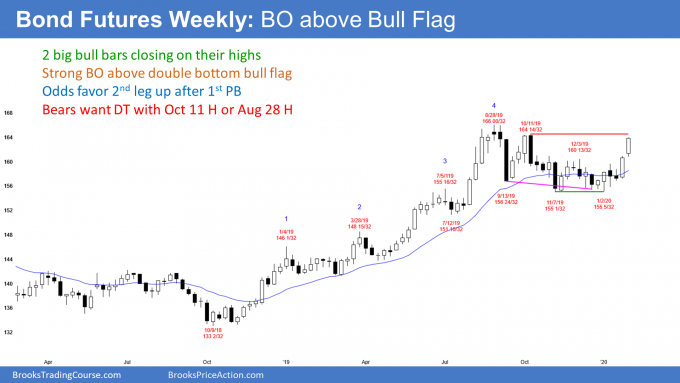
The 30 year Treasury bond futures market has been sideways for 6 months. On the monthly chart (not shown), there were 4 consecutive bear bars after a 2019 parabolic wedge rally. That is a weak bull flag. Traders expect a 2nd leg sideways to down.
On the weekly chart, the past 2 weeks were big bull bars closing near their highs. For the past 6 weeks, I have been saying that the bond market would rally. The bonds broke far above the 3 month trading range 2 weeks ago. The breakout was surprisingly big. Traders therefore expect at least a small 2nd leg up. As a result, they will look to buy the 1st reversal down. Consequently, the downside risk is small for the next couple weeks.
Conflicting signals on weekly and monthly charts
How should traders reconcile the monthly and weekly charts? The monthly chart should have a 2nd leg sideways to down. It typically would come from a lower high.
The weekly chart should have at least a small 2nd leg sideways to up. There is room to the all-time high for the weekly chart to have a pullback and a 2nd leg up, with that 2nd leg up staying below the August all-time high.
But even if the bulls get a new high, it will probably fail to go far above the August high. The 6 month trading range will likely continue for at least a few more months.
What about zero interest rates?
I have discussed this several times. The American public will not accept zero interest rates. Therefore, bonds probably cannot break far above the August all-time high.
Also, there is a 10 year nested wedge top on the monthly chart (I have shown it many times in prior Weekend Updates). Even though 2019 broke above the top, the breakout was small. The bond market is probably creating a top that will last for 20 years. Such a major reversal can take years to complete. It is like turning a supertanker on the ocean. The turn takes several miles. A turn in a 30 year bull trend takes several years.
EURUSD weekly Forex chart:
Double higher low major trend reversal, but in trading range
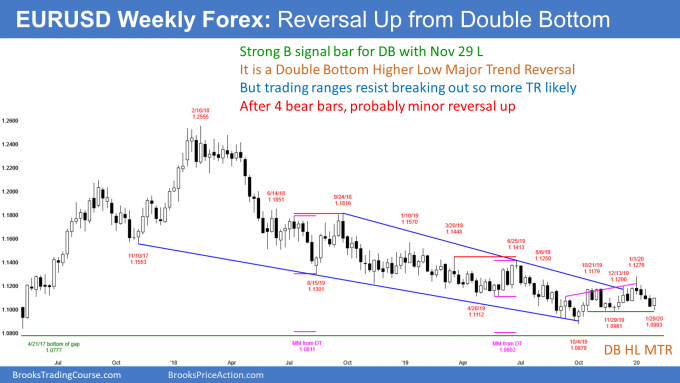
The EURUSD weekly Forex chart broke below 1.10 this week and reversed up. The bulls see the reversal as forming a higher low double bottom with the November 29 low.
This is therefore a double bottom higher low major trend reversal. This week is a buy signal bar. But there have been many buy and sell signals for 2 years. None has resulted in a trend. Consequently, traders continue to look for legs up and down to reverse every few weeks.
After 4 consecutive bear bars, the 1st reversal up will probably be minor. This is true despite this week was being a big bull bar closing near its high.
Look at the swings up and down over the past year. All have had at least 2 legs. Traders expect that there will be at least a small 2nd leg sideways to down before the bulls can get more than a 3 week rally from here.
Will the EURUSD go up or down over the next month?
What happens if the weekly chart rallies for a few weeks and reverses down from a lower high? Traders will see the rally as the right shoulder of a head and shoulders top. The left shoulder would be the October 21 lower high.
If however, the next several weeks are big bull bars and they break above the January high, traders will begin to believe that the 2 year bear trend is reversing up into a bull trend.
Traders continue to correctly believe that there will eventually be a rally up to the September 2018 high. That was the start of the bear channel. The start of the bear channel is a reliable magnet.
It is currently not yet clear that the bear trend and 6 month trading range have ended. Until they clearly have, the odds are that hey have not. Traders will continue to look for reversals every few weeks.
Monthly chart has outside down candlestick in January
January traded above the December high and then below the December low. It therefore formed an outside down candlestick on the monthly chart (not shown).
While an outside down bar can be bearish, context is important. The monthly chart has been in a tight trading range for 6 months. An outside bar in a tight trading range does not change the pattern. The chart is still in a tight trading range.
That is a limit order market. Consequently, there will probably be more buyers below the prior bar than sellers. It is more likely that February will be another sideways bar than the start of a bear breakout.
Monthly S&P500 Emini futures chart:
January is minor sell signal bar on Emini monthly chart
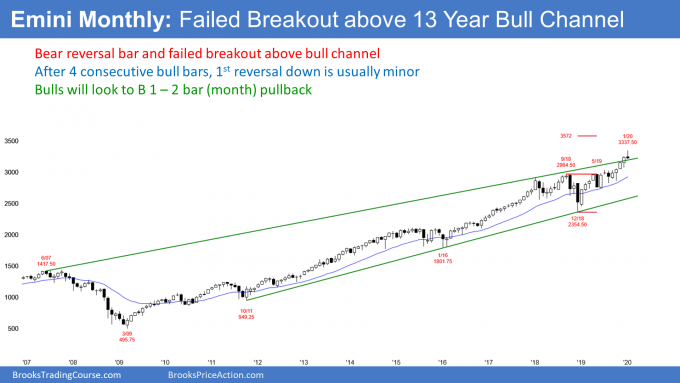
The monthly S&P500 Emini futures chart formed a small bear reversal bar in January. The bears wanted January to be a big bear bar closing on its low. It would then have been a stronger sell signal bar for a failed breakout above the 13 year bull channel.
I have written several times about the bull channel. I kept making the point that a breakout above a bull channel typically reverses back down within 5 bars. January is the 2nd bar of the breakout and it is reversing down.
However, the prior 4 months were all bull bars closing near their highs. While climactic, that is a strong bull breakout. Traders believe that the 1st reversal down will be minor and that there will then be at least a small 2nd leg up.
A minor reversal is often just a 1 – 2 bar pullback. Since this is a monthly chart, traders expect any selling to last a month or two. The bears will probably need at least a micro double top before they can get more than a 2 bar reversal down.
It is important to consider what will happen if February is a big bear bar closing near its low. Traders would then look for the selloff to test the middle of the channel at around 2900.
Weekly S&P500 Emini futures chart:
At least 2 legs down after buy climax
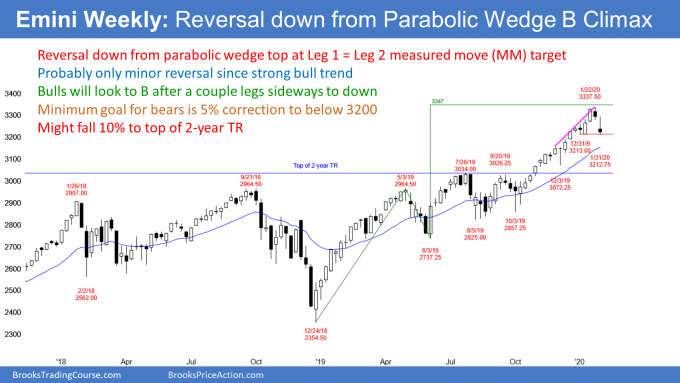
The weekly S&P500 Emini futures chart traded below last week’s low. It therefore triggered a minor weekly sell signal.
The sell signal was at the top of the 3rd leg up in a 4 month tight bull channel. That means that the rally was a parabolic buy climax. After an extreme buy climax, traders expect more than a 1 bar pullback.
Furthermore, I wrote 2 weeks ago that the Emini would soon begin a 5% correction. That is because the 2 big bull bars on the weekly chart in mid-January formed the strongest consecutive bull bars late in a bull trend.
When that happens, there is a 60% chance that the next week will be the top, or there will be one more brief leg up and that will be the top.
There was a similar pattern in January 2018. That time, there was a one bar 2nd leg up, and then a 10% correction. This time, the Emini immediately reversed after the 2 buy climax bars.
Can the correction end at 4% instead of 5%?
This week’s low is 4% from the high. It reached the bottom of the 2 big bull bars on the weekly chart. I have been saying that the bottom of the most recent buy climax was the 1st target once there was a reversal. The bears reached that target in Friday.
Can the Emini form a double bottom with that low and resume up next week? There are several problems with this. Friday’s selloff was surprisingly strong on the daily chart. A Bear Surprise Bar typically has at least a small 2nd leg sideways to down. Also, a reversal down from a buy climax typically has at least 2 legs down.
Next, another common target after a buy climax is a test of the 20 week EMA. That is now around 3160. Then there is the issue of psychological support.
Psychological support
Psychological support can be important. Many traders simply how they think of the market. That makes round numbers like 100, 500, 1000, 3,000 etc. important. For example, 3000, 3100, 3200, and 3300 have all been magnets in the Emini.
In terms of pullbacks, traders look to buy when the market has fallen 1%, 2%, 5%, 10%, or 20%. Look at last year. There were many pullbacks that ended almost exactly at 5, 10 or 20%. Once a selloff approached the target, many bulls stopped buying. They knew that a pullback that gets near support, even psychological support, will usually reach the support before reversing up.
The current selloff is now 4%. Many bulls will not buy unless it falls to at least 5%. The result is that a 4% pullback usually grows into a pullback that is 5% or more.
Daily S&P500 Emini futures chart:
Bear Surprise Bar makes another leg down likely
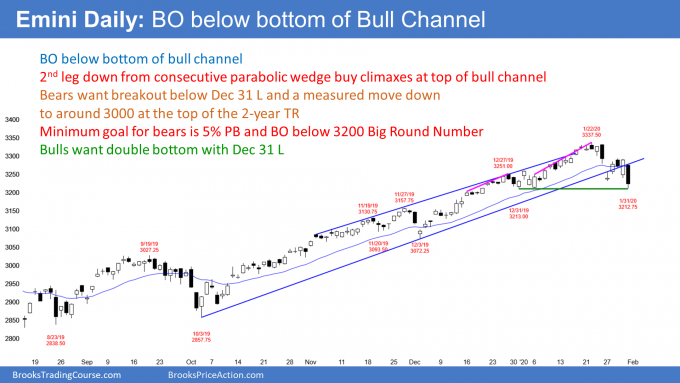
The daily S&P500 Emini futures chart had several big days up and down over the past couple of weeks. Because of the consecutive big bull bars on the weekly chart, I wrote 2 weeks ago that the Emini had a 60% chance of beginning at least a 5% correction within 3 weeks. It began a few days after my report.
Friday was the biggest bear bar on the daily chart since the corrections from July to October last year. When a bar is surprisingly big, many bears missed the short and want to short a rally. There are many bulls who now have decided that their longs are bad. They, too, want a rally so that they can exit with a smaller loss.
With both bulls and bears looking to sell the 1st 2 – 3 day rally, there will usually be at least a small 2nd leg sideways to down. As a result, traders expect that the 1st reversal up from a Bear Surprise Breakout will be minor. They will not aggressively buy until there is at least one more leg down and then a 2nd attempt to reverse up.
It is important to remember that the 4 month bull trend has been strong. If the Emini reverses up strongly next week, traders will conclude that the correction is over. At the moment, there is a 70% chance of at least slightly lower prices.
Why might the correction reach 5%?
A selloff from a buy climax typically tests the bottom of the most recent leg up. That is the January 6 low of 3213.25, which is about a 4% correction. Traders like 2, 5, 10, and 20% corrections. Many look to buy at those levels. Four percent is near 5%. Many bulls will not buy until they get that extra 1%.
Also, the 3200 Big Round Number is a magnet, and it is below that January 6 low. Consequently, traders will expect at least a 5% correction, which is at 3170.
The 4 month rally broke above a 2 year trading range. Markets usually come back to test the breakout point. If the bulls buy again at that price, traders will be more confident that the trend up will continue. Therefore, traders have to consider the possibility of a pullback to the top of the 2 year range at around 3000.
If it happened, the pullback would be about 10%. But traders see the monthly and weekly bull trends as strong. They will therefore buy a reversal up from the pullback, whether it is 5 or 10%.
Trading Room
Traders can see the end of the day bar-by-bar price action report by signing up for free at BrooksPriceAction.com. I talk about the detailed Emini price action real-time throughout the day in the BrooksPriceAction.com trading room. We offer a 2 day free trial.
Charts use Pacific Standard Time
When I mention time, it is USA Pacific Standard Time (the Emini day session opens at 6:30 am PST, and closes at 1:15 pm PST). You can read background information on the intraday market reports on the Market Update page.


Hi Al, first of all thank you very much for your work, for your books and for your courses, but there is a doubt that i can not find the answer and i would like to know your opinion and it is about if the SP500 future index is moved by traders and the cash index is the result of the 500 companies pondered move, how can they have the same move in the market hours? Should i make my setup with the cash index? Shall i take into account the overnight data to my analysis?
Thank you very much for your time.
Juan
The cash index is the actual current average price of the 500 stocks that make up the index. The Emini is a futures contract and it represents the expected future price.
For example, the price of the March futures contract is what traders expect the price of the cash index to be at the instant the futures contract expires.
The price of both theoretically move constantly 24 hours a day, even when the markets are closed. They are almost perfectly linked.
Traders should base trading decisions on the market they are trading. If a trader is trading the day session of the Emini, he is better off only looking at that chart and ignoring everything else.
The shorter the time frame, the more important it is to only look at the chart of the market you are trading.
If instead a trader was buying options and planning to hold for at least a couple weeks, it does not matter if he bases his decision on the appearance of the cash index, Emini, or SPY.